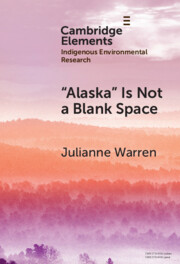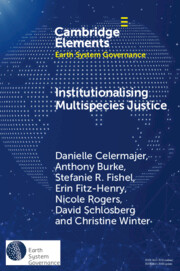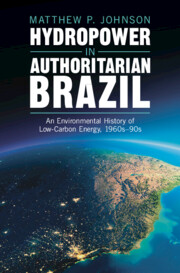Refine search
Actions for selected content:
115 results
9 - Environmental Justice, Circular Economies, and Green Living
-
-
- Book:
- The Circular Economy and Liveable Cities
- Published online:
- 05 September 2025
- Print publication:
- 04 September 2025, pp 135-145
-
- Chapter
- Export citation

‘Alaska’ is Not a Blank Space
- Unsettling Aldo Leopold's Odyssey
-
- Published online:
- 28 August 2025
- Print publication:
- 25 September 2025
-
- Element
- Export citation
3 - Climate Change Worldviews and the Scale of Environmental Justice
- from Part I - Movement Politics
-
-
- Book:
- Stability and Politicization in Climate Governance
- Published online:
- 07 August 2025
- Print publication:
- 21 August 2025, pp 35-48
-
- Chapter
-
- You have access
- Open access
- HTML
- Export citation
Renter willingness to pay for urban green space
-
- Journal:
- Agricultural and Resource Economics Review , First View
- Published online by Cambridge University Press:
- 20 August 2025, pp. 1-20
-
- Article
-
- You have access
- Open access
- HTML
- Export citation
Co-opting the state: mobilizing environmental justice claims in a regulatory agency
-
- Journal:
- Law & Society Review / Volume 59 / Issue 1 / March 2025
- Published online by Cambridge University Press:
- 28 March 2025, pp. 82-105
- Print publication:
- March 2025
-
- Article
-
- You have access
- Open access
- HTML
- Export citation

Institutionalising Multispecies Justice
-
- Published online:
- 29 January 2025
- Print publication:
- 27 February 2025
-
- Element
-
- You have access
- Open access
- HTML
- Export citation
Decrecimiento y agroecología: La experiencia del Movimiento de Trabajadores Rurales Sin Tierra (MST) en campamentos y asentamientos rurales en el Gran São Paulo, Brasil
-
- Journal:
- Latin American Research Review / Volume 60 / Issue 2 / June 2025
- Published online by Cambridge University Press:
- 16 December 2024, pp. 388-409
-
- Article
-
- You have access
- Open access
- HTML
- Export citation
Indigenous Advocacy and the Compliance Mechanisms of the World Heritage Convention: a TWAIL Reading
-
- Journal:
- International Journal of Cultural Property / Volume 32 / Issue 1 / February 2025
- Published online by Cambridge University Press:
- 04 December 2024, pp. 58-75
-
- Article
-
- You have access
- Open access
- HTML
- Export citation
8 - Clare and Ecocriticism
- from Part II - Clare the Naturalist
-
-
- Book:
- The Cambridge Companion to John Clare
- Published online:
- 14 November 2024
- Print publication:
- 21 November 2024, pp 120-134
-
- Chapter
- Export citation
Is air pollution increasing in poorer localities of Mexico? Evidence from PM 2.5 satellite data
-
- Journal:
- Environment and Development Economics / Volume 30 / Issue 1 / February 2025
- Published online by Cambridge University Press:
- 16 October 2024, pp. 52-69
-
- Article
-
- You have access
- Open access
- HTML
- Export citation
From Cadarese to Morasco: the creation of a Fascist hydroscape in alpine space after 1928
-
- Journal:
- Modern Italy / Volume 30 / Issue 1 / February 2025
- Published online by Cambridge University Press:
- 19 September 2024, pp. 39-55
- Print publication:
- February 2025
-
- Article
-
- You have access
- Open access
- HTML
- Export citation

Hydropower in Authoritarian Brazil
- An Environmental History of Low-Carbon Energy, 1960s–90s
-
- Published online:
- 09 July 2024
- Print publication:
- 27 June 2024
1 - Introduction
-
- Book:
- Reviving Rural America
- Published online:
- 20 June 2024
- Print publication:
- 27 June 2024, pp 1-23
-
- Chapter
- Export citation
6 - The Myth of Rural Radicalism
-
- Book:
- Reviving Rural America
- Published online:
- 20 June 2024
- Print publication:
- 27 June 2024, pp 130-155
-
- Chapter
- Export citation
Law, Colonial-Capitalist Floods, and the Production of Injustices in Eastern India: Insights for Climate Adaptation
-
- Journal:
- Transnational Environmental Law / Volume 13 / Issue 2 / July 2024
- Published online by Cambridge University Press:
- 07 May 2024, pp. 264-285
-
- Article
-
- You have access
- Open access
- HTML
- Export citation
Urban green space exposure is low and unequally distributed in an Amazonian metropolis
-
- Journal:
- Environmental Conservation / Volume 51 / Issue 3 / September 2024
- Published online by Cambridge University Press:
- 17 April 2024, pp. 168-178
-
- Article
-
- You have access
- Open access
- HTML
- Export citation
The Illusion of Harmony: Power, Politics, and Distributive Implications of Rights of Nature
-
- Journal:
- Transnational Environmental Law / Volume 13 / Issue 1 / March 2024
- Published online by Cambridge University Press:
- 12 March 2024, pp. 12-34
-
- Article
-
- You have access
- Open access
- HTML
- Export citation
The Green Agenda: Why the Provision and Development of Gypsy/Traveller Sites in Scotland is a Health Hazard as Much as an Accommodation Priority
-
- Journal:
- Social Policy and Society / Volume 23 / Issue 4 / October 2024
- Published online by Cambridge University Press:
- 16 February 2024, pp. 938-950
- Print publication:
- October 2024
-
- Article
-
- You have access
- Open access
- HTML
- Export citation
The development of a Gender, Inclusion and Diversity Framework for inclusive Nature-based Solutions in cities
-
- Journal:
- Research Directions: One Health / Volume 2 / 2024
- Published online by Cambridge University Press:
- 15 January 2024, e1
-
- Article
-
- You have access
- Open access
- HTML
- Export citation
5 - Ghost Acres
-
- Book:
- The Metamorphosis of the Amazon
- Published online:
- 13 December 2023
- Print publication:
- 21 December 2023, pp 119-146
-
- Chapter
- Export citation
